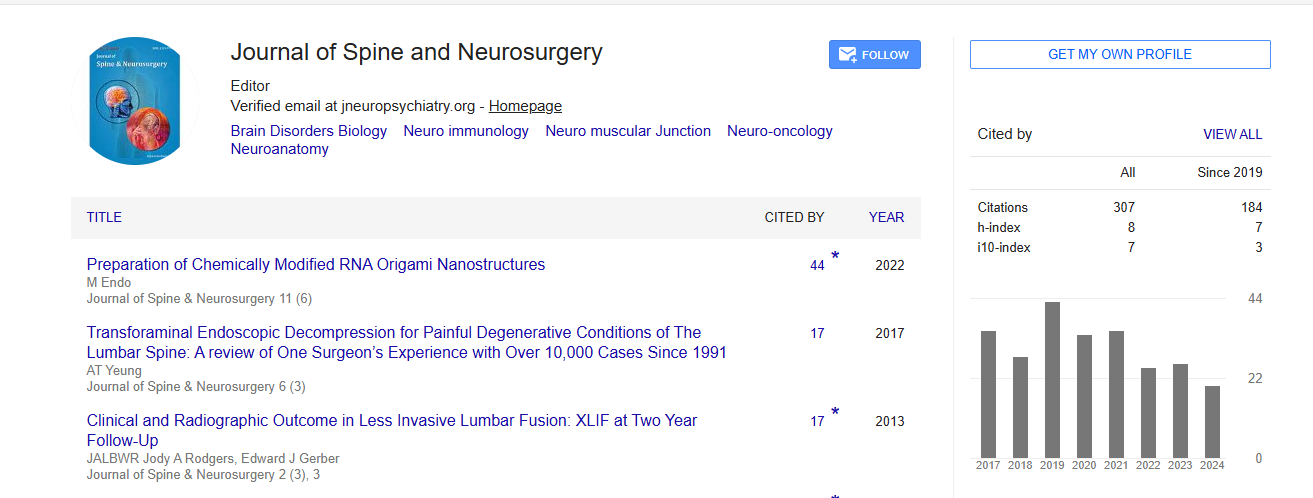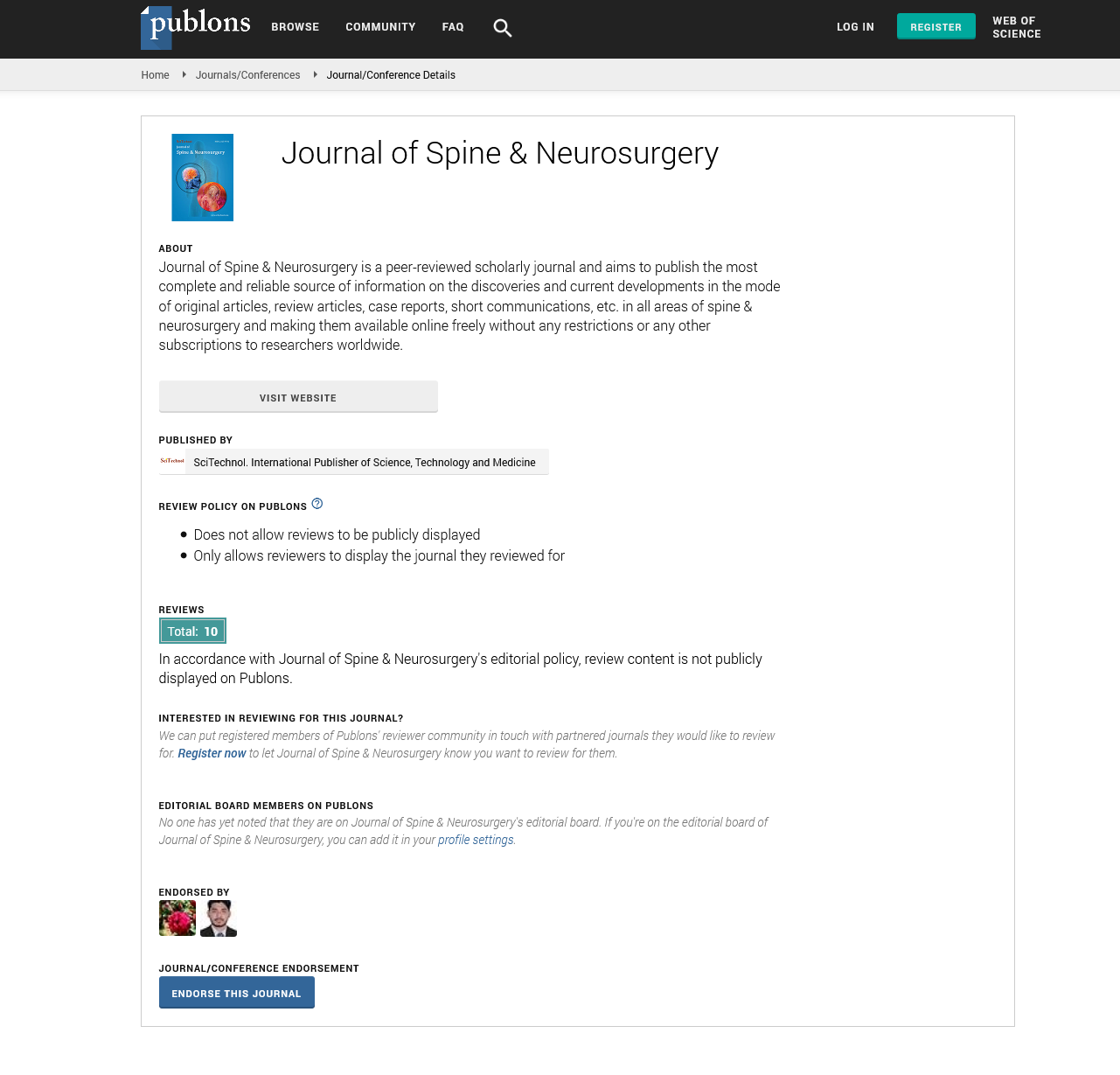Research Article, J Spine Neurosurg Vol: 5 Issue: 6
Simple 'Do it Yourself' System for Patients Database
| Sassi M1, Spada A1, Pascale V1, Pascale W1, Lavanga V2*, Sansone VC2 and Boria P3 | |
| 1Divisione Ginocchio II e chirurgia artroscopica, IRCCS Galeazzi Orthopaedic Institute, Milan, Italy | |
| 2Clinica Ortopedica, Irccs Galeazzi Milano, Italy | |
| 3SGPB Medicina Occupazionale, Milan, Italy | |
| Corresponding author : Dr. Vito Lavanga
Clinica Ortopedic, IRCCS Galeazzi Orthopaedic Institute, Milan, Italy Tel: +39 392 3991 841 E-mail: v.lavanga@gmail.com |
|
| Received: June 03, 2016 Accepted: July 12, 2016 Published: July 22, 2016 | |
| Citation: Sassi M, Spada A, Pascale V, Pascale W, Lavanga V, et al. (2016) Simple “Do it Yourself†System for Patients Database. J Spine Neurosurg 5:6. doi:10.4172/2325-9701.1000246 |
Abstract
Objectives: To Illustrate An EasyToUse Tool For Collection Of Clinical Follow-up Data. To Obtain An Effective And Reliable System For The Collection And Management Of Clinical Records In FollowUp Studies. To Obtain AutomaticallyUpdated, Anonymous Records Charting The Evolution Of Symptoms After Surgery. Methods: We Designed A “Do It Yourself” Web Survey Using Google Forms And Alerted Patients Via SMS (Short Message System) To Complete It. We Developed An EasyToUse System To Investigate Follow-up Results, And Tested It On A Series Of Patients Treated Surgically For Degenerative Lumbar Disc Disease. Our Methodological Approach Is Based On Fast And Do It Yourself (DIY) Web Based Tools. Considering Our Past Experience Of Collecting FollowUp Data With Traditional HardCopy Documents, Our System Proved To Be More Agile And TimeEfficient. Results: Data Collection Lasted 40 Days, Differing In Average Among The Age Groups. Overall Compliance Reached 100% Conclusions: Our method proved to be highly effective, requiring little effort from the investigators. Collected data could be combined to achieve greater sample sizes for longitudinal webbased studies.
Keywords: Clinical methodology; Google forms; Webbased surveys; Decision support systems; Computer assisted clinical; Lumbar spine surgery
Keywords |
|
| Clinical methodology; Google forms; Webbased surveys; Decision support systems; Computer assisted clinical; Lumbar spine surgery | |
Introduction |
|
| Webbased data survey systems are a new tool for data collection because they introduce runtime verification during data submission and these systems can be managed by operators and directly administered to the desired cohort [1,2]. They are ideal for achieving a wide geographic coverage of the target population, dealing with sensitive topics | |
| and are less resource demanding than other data collection methods. These survey questionnaires can be delivered electronically, thus maximizing the scalability and speed of data collection, while reducing costs. In recent years, the use of applications running on smart devices (i.e., smartphones and tablets) for this purpose has received considerable | |
| attention [3]. Google Forms is an easytoaccess, low informatics utility for the creation of surveys, questionnaires and forms. Files can be exported using a unique public URL (Appendix A). Results obtained from surveys can be published online, (1) guaranteeing privacy issues and (2) providing useful and reliable information’s on average surgical outcome to future patients. | |
| We report our experience with Google Forms of gathering preand postoperative clinical data from a cohort of patients who had received treatment for degenerative lumbar disc disease. | |
Materials |
|
| Study design | |
| Ninety-seven Italian patients operated for lumbar arthrodesis were evaluated according to the Oswestry Disability Index (ODI) [4], in order to analyze the results of the surgery they had undergone. The study was designed as cross-sectional. Assessments were performed preoperatively and at 6, 12 and 24 months postoperative. The Oswestry Disability Index (ODI) is derived from the Oswestry Low Back Pain Questionnaire. It is widely accepted to | |
| Quantify disability in back disorders [4]. During these assessments, subjective disability was also measured using the validated Finnish version of the Oswestry Disability Index, where 0 % represents no disability and 100 % extreme debilitating disability [5]. | |
| Study phases | |
| Phase 1. Planning: Patients’ mobile phone numbers were taken from the hospital archive. A web based editable file was then designed using Google Forms [6] which reproduced the Oswestry Questionnaire [5]. A public URL was pasted onto our private website: www.colonna.info | |
| Phase 2. Preliminary Results: The software automatically creates a spreadsheet containing the each patient’s responses to the questionnaire. Automatic processes and system reliability is checked through serial personal tests. | |
| Phase 3. ActiveAlert Research: A 160 character SMS text message was sent with bulk SMS sender Site [7] to remind patients who had not responded to Phase 2. | |
| Phase 4. Data mining: The data were analyzed to predict back disability after surgery. Anonymous, realtime updated charts were published online. | |
Methods |
|
| A web survey was created using Google Forms [6], consisting of the 4 evaluation points: preoperative, 6, 12, 24 months in the postsurgical period. Questionnaires were accessible via our internet site (www.colonna.info). Data entry was monitored via web. Patients were subsequently alerted via SMS and invited to complete the missing surveys. In order for a Patient to complete the different follow-up endpoint, the survey had to be sent multiple times. | |
| An automatic spreadsheet was then generated with no need for human supervisors. | |
| Privacy issues: Patients were obliged to accept and flag a privacydisclaimer. Collected data were anonymized and automatically used to create charts. Investigators were the only ones allowed to visualize the result spreadsheets. Sensible data like phone numbers and clinical values were stored on private accounts with double step verification access method. A 128 bit ssl https connection was required at every access using The Onion Router to anonymize our ip. | |
Results |
|
| Data collection lasted from June 7th, 2015 until July 14th, 2015. Data entry could be monitored by visiting the online spreadsheet of answers and derived statistics (Appendix B). Sixty-one percent out total entries was completed in 2 weeks, while all surveys were completed in one month (Figure 1). Age distribution was composed by three clusters: 2450 yrs (19%), 5170 yrs (54%), 7180 yrs (27%). | |
| Survey obtained 6.208 entries (16 questions times 97 patients times 4 follow-up endpoints). Timeline of answers: 3547 entries (57%) at week 0 to 2, 2489 entries (40%) at week 2 to 4, 172 entries (3%) at week 4 to 6 (Figure 1). Overall compliance was 100%. All vital statistics and contacts were automatically grabbed and checked. There was no need for human intervention after launching the system. | |
| Figure 1: Representative signals of AIMS sum signal and humidity of the exhaled breath sample measured with ChemPro®100 and multicapillary column used. The AIMS spectrum from the maximum point of the AIMS sum signal was analyzed further. | |
Discussion |
|
| We report our experience in implementing follow-up study of our surgical series with an internet based survey. No human intervention was needed after system start, while reaching 100% compliance. Programs were based on Google Forms. Surveymonkey, Typeform, Limesurvey were considered equivalent. We chose Google Forms because it is free of charge and with extreme user-friendly features. Searching for a similar approach in the Literature, we found some studies concerning the use of PDAs (Personal Digital Assistants) and personal computers as paper substitutes, | |
| Investigating their characteristics and advantages [7-9]. Similar projects were developed like Singleton KW using C#, ASP.net, and SQL Server by multiple programmers over the course of a year running on a tablet pc. Substituting paper with digital devices is effective in reducing paper and simplifying collection and storage of data [10]. Marcano Belisario JS et al. suggested the use of apps and electronic questionnaires might not affect data validity [3]. | |
| Finally, it has already been noticed [11-13] that, while somewhat more friendly to the patient, paper questionnaires need to be sent back via email/ post office. This logistic issue eventually affects the reliability of data collection. Age-related distinct trends regarding surveys completion were immediately noticed by the investigators. A rapid adherence to this relatively new system was observed for 24to50 years old Patients, evidently well acquainted to informatics. On the other hand, for patients aged 70 years or more, more traditional methods of contact, such as phone calls and Short Message system (SMS) were often required, as well as help by younger relatives. | |
| Direct phone calls were also used for patients failing to respond to website and SMS. | |
| Talking the patient out of their resistance against the informatics instrument had also the positive effect of strengthening the bond between the surgeon and the patient. Doctor patient relationship is a keystone of care. A stable doctor patient relationship is required, especially with elderly patients. Preliminary information’s about this automated system (i.e. during clinical and preoperative evaluations) could further improve compliance in web based follow-up studies. Starting from this, a functional and effective yet reliable system is assured: no paper was used in this study, no manual transcription of answers was performed, no postproduction time was employed. | |
| Finally, one of the most significant tool this system gave us is indeed the postsurgical results’ graph. Future candidates to surgery found it very useful in order to understand what to expect in terms of symptoms improvement and returntowork timing. | |
Conclusions |
|
| Our system proved to be reliable and efficient considering (1) its versatility for statistical studies and (2) ethics in information of the Patients. Patients’ Informatics like knowledge proved to be a key factor on both these features. Stressing these new opportunities at every interaction with the patient is then of paramount importance. | |
References |
|
|
|
 Spanish
Spanish  Chinese
Chinese  Russian
Russian  German
German  French
French  Japanese
Japanese  Portuguese
Portuguese  Hindi
Hindi 
